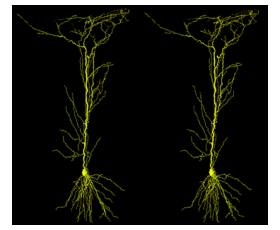Project Description

Alzheimer’s disease affects over 46 million people worldwide, estimated to triple by the year 2050. It has a long preclinical stage and, before any clinical symptoms appear, pathological processes are observed in the hippocampus and entorhinal cortex, key brain structures responsible for memory encoding and retrieval. AD cannot be prevented, halted or cured today, and new interdisciplinary ways are urgently needed for the understanding and treatment of this devastating disease. Recent experimental evidence supports the fundamental role of Alzheimer’s disease-related peptides early in the pathology: in particular the most widely studied Amyloid beta (Aβ), and the less investigated Amyloid eta (Aη) and Amyloid precursor protein (APP) C-terminal peptide (AICD).
Their differential effects on synaptic function and intrinsic excitability of hippocampal CA1 pyramidal neuron at a single cell level are currently being investigated. However, the dose-dependent impact and complex interaction effects of Aβ, Aη, AICD on hippocampal synaptic plasticity, CA1 network activity, memory encoding and retrieval capacity and dynamics remain largely unknown.
The interdisciplinary consortium will perform ex-vivo whole-cell patch clamp electrophysiology recordings (Dr. Helene Marie, Institut de Pharmacologie Moléculaire et Cellulaire, Valbonne, France), computational modeling of hippocampal synaptic plasticity (Prof. Ausra Saudargiene, Lithuanian University of Health Sciences, Lithuania), of neuronal excitability and of biologically realistic large-scale CA1 network (Prof. Michele Migliore, Institute of Biophysics, Palermo, Italy) under control and Alzheimer’s disease conditions. The consortium has a proven track-record of experimental, theoretical and computational expertise to successfully achieve these goals.
The project extends beyond the state-of-the-art by integrating ex-vivo experimental data into multi-scale in silico approaches to suggest potential targets for more effective treatments in the initial phase of Alzheimer’s disease. By including the models into the Brain Simulation Platform of the Human Brain Project, the project will provide to the community an essential multi-scale modelling tool for this devastating disease.
Alzheimer’s disease affects over 46 million people worldwide, estimated to triple by the year 2050. It has a long preclinical stage and, before any clinical symptoms appear, pathological processes are observed in the hippocampus and entorhinal cortex, key brain structures responsible for memory encoding and retrieval. AD cannot be prevented, halted or cured today, and new interdisciplinary ways are urgently needed for the understanding and treatment of this devastating disease. Recent experimental evidence supports the fundamental role of Alzheimer’s disease-related peptides early in the pathology: in particular the most widely studied Amyloid beta (Aβ), and the less investigated Amyloid eta (Aη) and Amyloid precursor protein (APP) C-terminal peptide (AICD).
Their differential effects on synaptic function and intrinsic excitability of hippocampal CA1 pyramidal neuron at a single cell level are currently being investigated. However, the dose-dependent impact and complex interaction effects of Aβ, Aη, AICD on hippocampal synaptic plasticity, CA1 network activity, memory encoding and retrieval capacity and dynamics remain largely unknown.
The interdisciplinary consortium will perform ex-vivo whole-cell patch clamp electrophysiology recordings (Dr. Helene Marie, Institut de Pharmacologie Moléculaire et Cellulaire, Valbonne, France), computational modeling of hippocampal synaptic plasticity (Prof. Ausra Saudargiene, Lithuanian University of Health Sciences, Lithuania), of neuronal excitability and of biologically realistic large-scale CA1 network (Prof. Michele Migliore, Institute of Biophysics, Palermo, Italy) under control and Alzheimer’s disease conditions. The consortium has a proven track-record of experimental, theoretical and computational expertise to successfully achieve these goals.
The project extends beyond the state-of-the-art by integrating ex-vivo experimental data into multi-scale in silico approaches to suggest potential targets for more effective treatments in the initial phase of Alzheimer’s disease. By including the models into the Brain Simulation Platform of the Human Brain Project, the project will provide to the community an essential multi-scale modelling tool for this devastating disease.